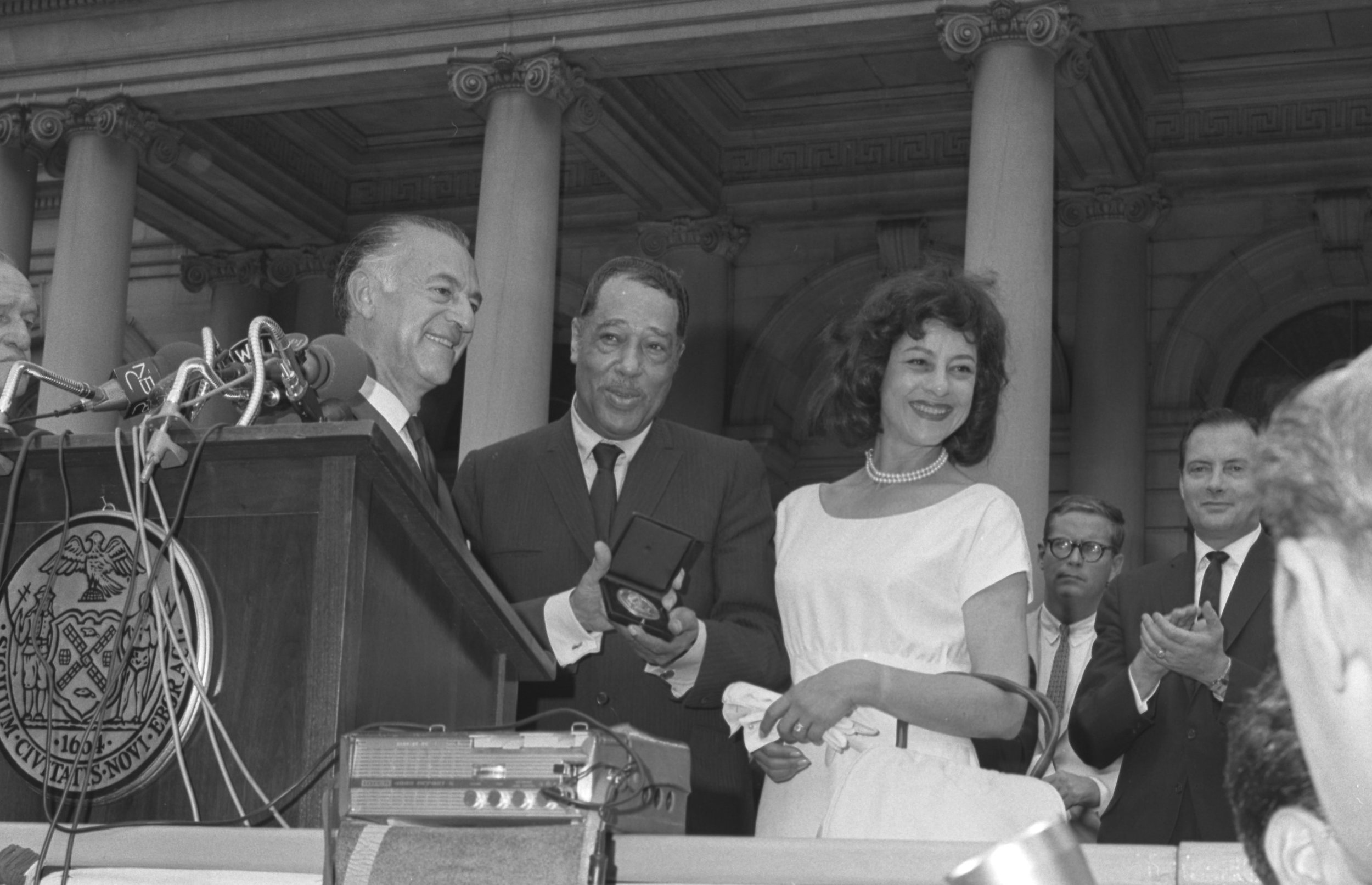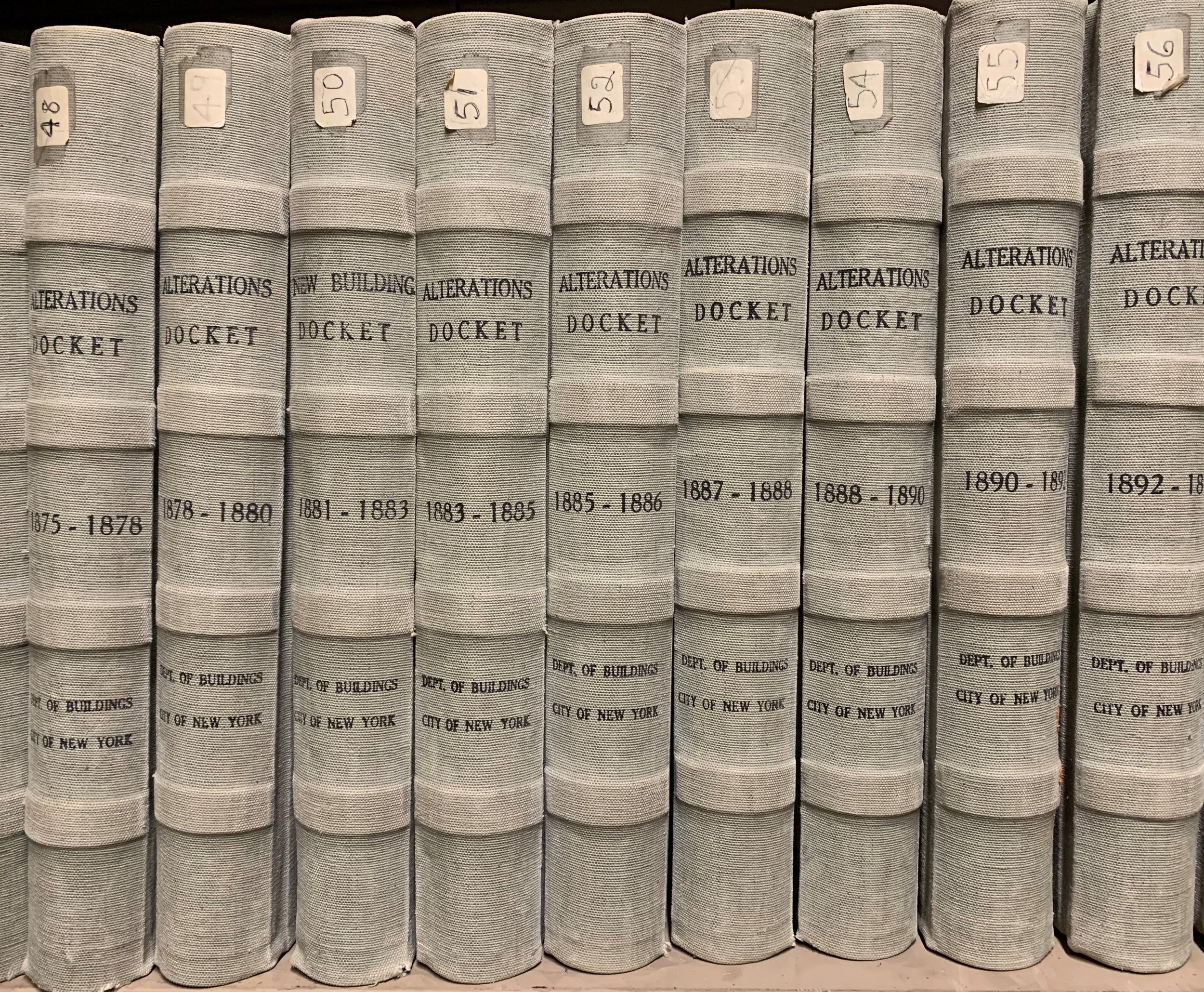For most of the 20th century, the City of New York ran the largest municipal broadcast organization in the United States, consisting of WNYC-FM, AM and TV. During this time, WNYC brought the diverse lives and cultures of the city into the homes of its residents through original entertainment, journalism and educational programming. Since the separation of WNYC from the City in 1996, the Municipal Archives has been caring for the thousands of films and video tapes from WNYC-TV, and thousands of radio recordings in partnership with the WNYC Foundation’s Archives. Some recently digitized items added to the online gallery show deep appreciation for the life and work of music legend Edward Kennedy “Duke” Ellington.
Duke Ellington, with Mrs. Ellington, receives the Bronx Medal from Acting Mayor Paul Screvane (left), August 2, 1965. Official Mayoral Photograph Collection. NYC Municipal Archives.
Duke Ellington Day was proclaimed by Mayor Michael Bloomberg on April 29th, 2009, which would have been the jazz legend’s 110th birthday. Ellington is famous for adding his piano to brass orchestral jazz with songs such as “It Don’t Mean a Thing (if it Ain’t Got that Swing),” and was house band leader of the influential and infamous prohibition era Harlem venue the Cotton Club. The City of New York has honored the composer several times for his work and 2009 was not the first Duke Ellington Day. In 1965, Duke Ellington was presented with the Bronze Medal by Acting Mayor Paul Screvane, and Mayor John V. Lindsay also proclaimed Duke Ellington Day on September 15th, 1969, in honor of his contributions to American culture. WNYC Radio and TV covered the two events.
WNYC recording, Duke Ellington Day, City Hall, August 2, 1965.
Long before the awards and honors, Ellington arrived in New York in 1923, leaving his successful career in his hometown of Washington, D.C. for opportunity in the vibrant art scene of Harlem. That Manhattan neighborhood was in the middle of a cultural awakening now described as the Harlem Renaissance, when many enduring works by African American artists were created. Aside from Ellington, other musical giants like Billie Holiday and Louis Armstrong wrote and performed in clubs across Harlem. Writers like Arthur Schomburg and Langston Hughes penned famous works such as ‘The Weary Blues’ in 1926 and visual artists Richmond Barthé and Meta Vaux Warwick Fuller portrayed the beauty of black physicality.
Duke Ellington had gained recognition as a member in other bands already, but his career really took off once he became the band leader at the Cotton Club. Although the venue was highly popular among its exclusively wealthy and white clientele, the real surge in popularity came when CBS began broadcasting the performances across the country, making Duke Ellington the first nationally-broadcast African American band leader. This popularity quickly led to short films with RKO Pictures and recording deals with major record labels.
Ellington and his band left the Cotton Club in 1931 and found great success in composing and recording original music, as well as touring internationally despite the onset of the Great Depression. Some of his most enduring work, like ‘Caravan’ and ‘It Don’t Mean a Thing’ were composed and performed for the first time during this period. Ellington also began to win major awards for his work when he scored a film titled ‘Symphony in Black’ (1935), featuring Billie Holiday, which won the Academy Award for Best Musical Short Piece that year.
WNYC-TV Collection, Duke Ellington and his band perform at Duke Ellington Day, with Mayor John V. Lindsay, City Hall Plaza, September 15, 1969. NYC Municipal Archives.
Ellington’s popularity waned during the 1940s, only to resurge in the 1950s and ‘60s after his headline-grabbing appearance at the 1956 Newport Jazz Festival. The resulting vinyl record of the performance has become the best-selling album of Ellington’s entire career. Soon he and his orchestra were in high demand to play at festivals across the country. Ellington spent the later years of his career split between expanding his discography and receiving awards and accolades for his decades of musical innovation. In addition to honors from the City of New York, Duke Ellington also received the Presidential Medal of Freedom, was inducted into the Hollywood Walk of Fame and won 12 Grammy’s as well as a Grammy Lifetime Achievement Award.
Although the original Cotton Club no longer exists, the indelible mark that Duke Ellington left on the City and its culture is evident not just in the awards he was given, but the material now preserved and publicly available through a grant from the Local Government Records Management Improvement Fund. You can find the WNYC-TV recording of the 1969 Duke Ellington Day on the Municipal Archive’s digital gallery along with hundreds of hours of WNYC-TV programming.











